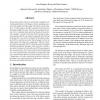Free Online Productivity Tools
i2Speak
i2Symbol
i2OCR
iTex2Img
iWeb2Print
iWeb2Shot
i2Type
iPdf2Split
iPdf2Merge
i2Bopomofo
i2Arabic
i2Style
i2Image
i2PDF
iLatex2Rtf
Sci2ools
CRV
2005
IEEE
2005
IEEE
An Object Detection System using Image Reconstruction with PCA
We present an object detection system that is applied to detecting pedestrians in still images, without assuming any a priori knowledge about the image. The system works as follows: In a first stage a classifier examines each location in the image at different scales. Then in a second stage the system tries to eliminate false detections based on heuristics. The classifier is based on the idea that Principal Components Analysis (PCA) can compress optimally only the kind of images that were used to compute the principal components (PCs), and that any other kind of images will not be compressed well using a few components. Thus the classifier performs separately the PCA from the positive examples and from the negative examples, when it needs to classify a new pattern it projects it into both sets of PCs and compares the reconstructions. The system is able to detect frontal and rear views of pedestrians, and usually can also detect side views of pedestrians despite not being trained f...
Related Content
| Added | 24 Jun 2010 |
| Updated | 24 Jun 2010 |
| Type | Conference |
| Year | 2005 |
| Where | CRV |
| Authors | Luis Malagón-Borja, Olac Fuentes |
Comments (0)

